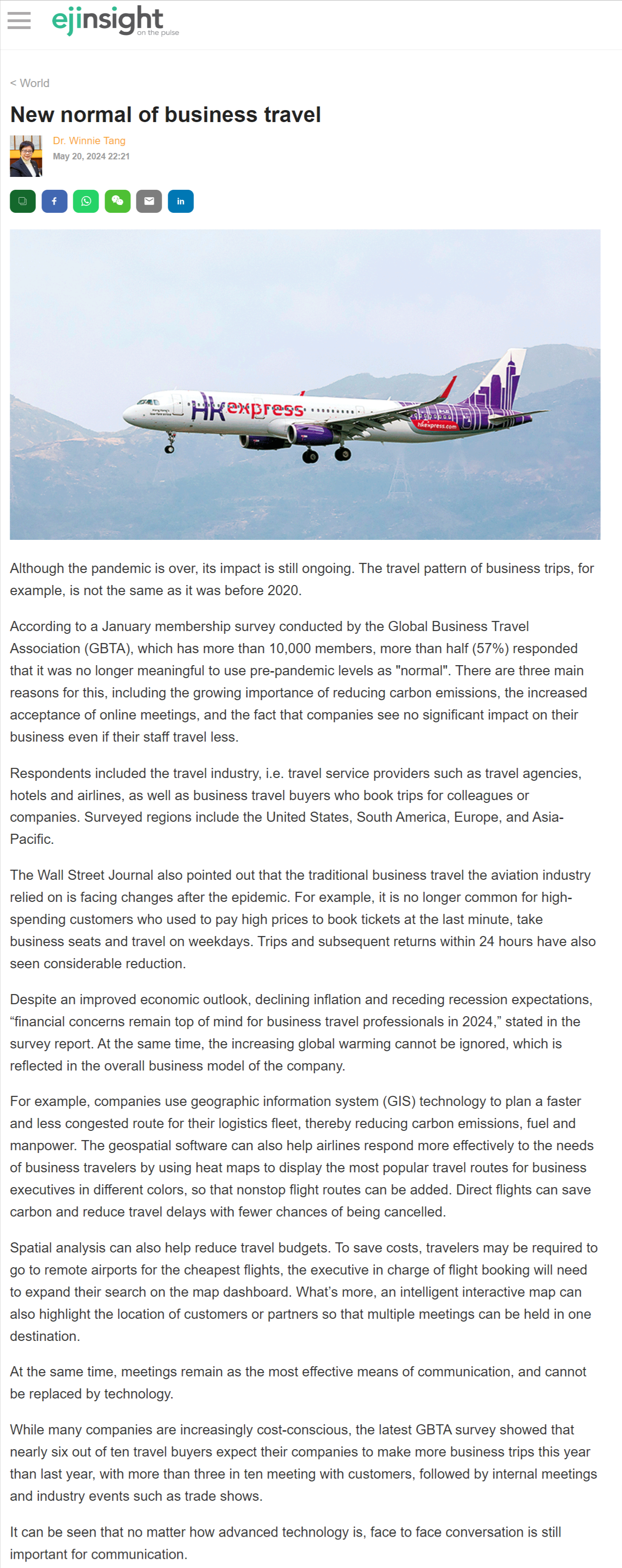網上版請按此

New normal of business travel
Although the pandemic is over, its impact is still ongoing. The travel pattern of business trips, for example, is not the same as it was before 2020.
According to a January membership survey conducted by the Global Business Travel Association (GBTA), which has more than 10,000 members, more than half (57%) responded that it was no longer meaningful to use pre-pandemic levels as "normal". There are three main reasons for this, including the growing importance of reducing carbon emissions, the increased acceptance of online meetings, and the fact that companies see no significant impact on their business even if their staff travel less.
Respondents included the travel industry, i.e. travel service providers such as travel agencies, hotels and airlines, as well as business travel buyers who book trips for colleagues or companies. Surveyed regions include the United States, South America, Europe, and Asia-Pacific.
The Wall Street Journal also pointed out that the traditional business travel the aviation industry relied on is facing changes after the epidemic. For example, it is no longer common for high-spending customers who used to pay high prices to book tickets at the last minute, take business seats and travel on weekdays. Trips and subsequent returns within 24 hours have also seen considerable reduction.
Despite an improved economic outlook, declining inflation and receding recession expectations, "financial concerns remain top of mind for business travel professionals in 2024," stated in the survey report. At the same time, the increasing global warming cannot be ignored, which is reflected in the overall business model of the company.
For example, companies use geographic information system (GIS) technology to plan a faster and less congested route for their logistics fleet, thereby reducing carbon emissions, fuel and manpower. The geospatial software can also help airlines respond more effectively to the needs of business travelers by using heat maps to display the most popular travel routes for business executives in different colors, so that nonstop flight routes can be added. Direct flights can save carbon and reduce travel delays with fewer chances of being cancelled.
Spatial analysis can also help reduce travel budgets. To save costs, travelers may be required to go to remote airports for the cheapest flights, the executive in charge of flight booking will need to expand their search on the map dashboard. What's more, an intelligent interactive map can also highlight the location of customers or partners so that multiple meetings can be held in one destination.
At the same time, meetings remain as the most effective means of communication, and cannot be replaced by technology.
While many companies are increasingly cost-conscious, the latest GBTA survey showed that nearly six out of ten travel buyers expect their companies to make more business trips this year than last year, with more than three in ten meeting with customers, followed by internal meetings and industry events such as trade shows.
It can be seen that no matter how advanced technology is, face to face conversation is still important for communication.
Dr. Winnie Tang
Adjunct Professor, Department of Computer Science, Faculty of Engineering; Department of Geography, Faculty of Social Sciences; and Faculty of Architecture, The University of Hong Kong